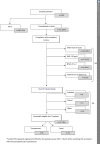Lung and heart-lung transplantation in pulmonary arterial hypertension
- PMID: 29161284
- PMCID: PMC5697851
- DOI: 10.1371/journal.pone.0187811
Lung and heart-lung transplantation in pulmonary arterial hypertension
Erratum in
-
Correction: Lung and heart-lung transplantation in pulmonary arterial hypertension.PLoS One. 2018 Jan 29;13(1):e0192100. doi: 10.1371/journal.pone.0192100. eCollection 2018. PLoS One. 2018. PMID: 29377947 Free PMC article.
Abstract
Background: Real use of lung (LT) and heart-lung (HLT) transplantation in pulmonary arterial hypertension (PAH) is unknown. The objectives were to describe the indication of these procedures on PAH treatment in a national cohort of PAH patients, and to analyze the potential improvement of its indication in severe patients.
Methods: Eligibility for LT/HLT was assessed for each deceased patient. Incident patients from REHAP diagnosed between January 2007 and March 2015 and considered eligible for LT/HLT were grouped as follows: those who finally underwent transplantation (LTP) and those who died (D-Non-LT).
Findings: Of 1391 patients included in REHAP, 36 (3%) were LTP and 375 (27%) died. Among those who died, 36 (3%) were D-Non-LT. LTP and D-Non-LT were equal in terms of age, gender, and clinical status. Ten percent of those who died were functional class I-II. Patients functional class IV were less likely to undergo LT (8.3% LTP vs. 30.6% D-Non-LT, p = 0.017). Patients with idiopathic and drug/toxin-associated PAH were more likely to undergo LT (44.4% LTP vs. 16.7% D-Non-LT, p = 0.011).
Conclusions: The present results show that the use of LT/HLT could double for this indication. Relevant mortality in early functional class reflects the difficulties in establishing the risk of death in PAH.
Conflict of interest statement
Figures




References
-
- McLaughlin VV, Shah SJ, Souza R, Humbert M. Management of Pulmonary Arterial Hypertension. J Am Coll Cardiol. 2015; 65: 1976–1997. doi: 10.1016/j.jacc.2015.03.540 - DOI - PubMed
-
- Humbert M, Sitbon O, Chaouat A, Bertocchi M, Habib G, Gressin V, et al. Survival in patients with idiopathic, familial, and anorexigen-associated pulmonary arterial hypertension in the modern management era. Circulation. 2010; 122: 156–163. doi: 10.1161/CIRCULATIONAHA.109.911818 - DOI - PubMed
-
- Escribano-Subias P, Blanco I, Lopez-Meseguer M, Lopez-Guarch CJ, Roman A, Morales P, et al. Survival in pulmonary hypertension in Spain: insights from the Spanish registry. Eur Respir J. 2012; 40: 596–603. doi: 10.1183/09031936.00101211 - DOI - PubMed
-
- Corris P, Degano B. Severe pulmonary arterial hypertension: treatment options and the bridge to transplantation. Eur Respir Rev. 2014; 23: 488–497. doi: 10.1183/09059180.00007214 - DOI - PMC - PubMed
-
- Galie N, Corris PA, Frost A, Girgis RE, Granton J, Jing ZC, et al. Updated treatment algorithm of pulmonary arterial hypertension. J Am Coll Cardiol. 2013; 62 (25 Suppl): D60–D72. doi: 10.1016/j.jacc.2013.10.031 - DOI - PubMed
MeSH terms
LinkOut - more resources
Full Text Sources
Other Literature Sources
Medical

